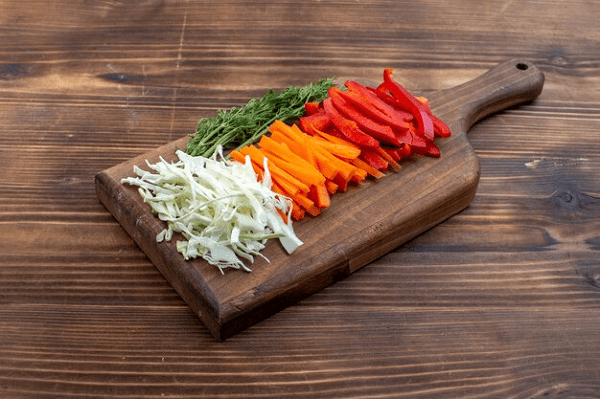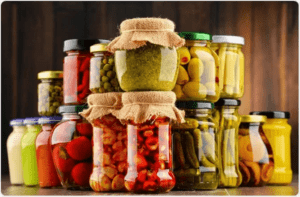Cuts of Vegetables- There are many different ways to cut vegetables, and the choice of cutting technique depends on the recipe and the desired texture and presentation. Here are some common vegetable cutting techniques:
- Dicing: Cutting vegetables into small, evenly-sized cubes. This is a common cut for onions, carrots, and potatoes.
- Mincing: Cutting vegetables into very fine pieces. Garlic and herbs are often minced.
- Chopping: Cutting vegetables into irregular, medium-sized pieces. This is less precise than dicing and is often used for things like bell peppers.
- Slicing: Cutting vegetables into thin, flat pieces. This is commonly done with cucumbers, zucchinis, and onions.
- Julienne: Cutting vegetables into thin, matchstick-sized strips. This cut is often used for carrots and bell peppers in salads or stir-fries.
- Brunoise: A very small dice, usually used for garnishes. Vegetables are cut into tiny, uniform cubes.
- Bias or Diagonal Cut: Slicing vegetables at an angle, which creates elongated, oval-shaped pieces. This is often used for vegetables like carrots and cucumbers.
- Chiffonade: Rolling leafy greens like spinach or basil into a cylinder and then slicing thinly, creating long, thin ribbons.
- Mandoline Slices: Using a mandoline slicer to create uniform, very thin slices of vegetables, such as for making potato chips or scalloped potatoes.
- Ribbon Cut: Using a peeler or mandoline to create wide, flat strips of vegetables, like zucchini or carrots.
- Florets: Breaking or cutting cauliflower and broccoli into small, individual, tree-like pieces.
- Coring: Removing the tough central core from vegetables like bell peppers or tomatoes.
- Hulling: Removing the stem and top portion of strawberries or tomatoes.
- Peeling: Removing the skin from vegetables like potatoes or carrots.
- Deseeding: Removing seeds from vegetables like cucumbers, bell peppers, or tomatoes.
The choice of cut can affect the texture, cooking time, and presentation of your dish, so it’s important to choose the right technique for your recipe. Additionally, knife skills and cutting techniques can significantly impact your efficiency in the kitchen, so it’s worth practicing and mastering these skills.
What is Cuts of Vegetables
“Cuts of vegetables” typically refers to the various ways in which vegetables can be sliced, diced, or prepared in different shapes and sizes. These cuts are used in cooking to achieve specific textures, appearances, and cooking times for different dishes. The choice of how vegetables are cut can affect the overall presentation and cooking characteristics of a meal.
The list I provided in my previous response outlines some common cutting techniques for vegetables. These cuts include dicing, mincing, chopping, slicing, julienne, and more. Each of these techniques serves a specific purpose in cooking and can be used in a variety of dishes to achieve different results.
For example, you might julienne carrots for a stir-fry to ensure even cooking, slice onions for a sandwich, or mince garlic for a sauce. The choice of cut depends on the recipe and the desired outcome in terms of flavor, texture, and appearance.
When is Required Cuts of Vegetables

The need for particular vegetable cuts depends on the recipe you are preparing. Here are a few scenarios where specific cuts of vegetables may be required:
- Uniform Cooking: In dishes where even cooking is crucial, such as stir-fries, soups, or stews, you might need to cut vegetables into uniform pieces to ensure they cook at the same rate.
- Presentation: Some dishes, like salads or garnishes, require specific vegetable cuts for aesthetic reasons. Julienned or thinly sliced vegetables can add an appealing visual element to a dish.
- Texture: The texture of vegetables can significantly impact a dish. For example, if you want a crunchy texture, you might use a julienne cut, while a mirepoix (a mix of diced carrots, celery, and onions) is often used for flavor but should cook down and almost disappear in a dish.
- Recipe Instructions: Many recipes provide specific instructions on how to cut vegetables. Following these instructions ensures that the dish turns out as intended by the recipe’s creator.
- Ingredient Integration: In recipes where vegetables are incorporated into a sauce or a puree, they are often finely minced or chopped to help them blend seamlessly into the dish.
In summary, the required cuts of vegetables depend on the specific recipe, the desired outcome in terms of flavor and texture, and sometimes the presentation of the dish. Always refer to the recipe’s instructions for guidance on how to cut and prepare the vegetables for your cooking project.
Where is Required Cuts of Vegetables
The specific location or context where you would need to use certain cuts of vegetables can vary, but it generally relates to the kitchen or culinary settings. Here are some common situations or places where required cuts of vegetables can be relevant:
- Home Kitchen: When you’re cooking at home, following specific vegetable cuts is essential to ensure that your recipes turn out as intended. This can apply to everyday meals or special occasions.
- Restaurants: Professional chefs and cooks in restaurants use specific vegetable cuts to maintain consistency in their dishes’ appearance and cooking. For example, a fine dining restaurant may use precise cuts for presentation.
- Catering Services: Caterers often prepare large quantities of food, and having uniform cuts is essential for consistency and presentation when serving events and parties.
- Culinary Schools: In culinary education and training, students learn various vegetable cutting techniques to develop their knife skills and culinary expertise.
- Food Processing Facilities: Large-scale food processing and manufacturing facilities may use specific cuts for packaged or processed foods.
- Food Photography and Styling: Food photographers and stylists may use specific cuts to make dishes look visually appealing for photographs and advertisements.
- Food Shows and Competitions: In televised cooking shows and culinary competitions, contestants often use precise vegetable cuts to impress judges and viewers with their skills.
The use of specific cuts of vegetables can vary widely, depending on the context, the culinary purpose, and the desired outcome. Whether you’re a home cook, a professional chef, or involved in any culinary-related field, the appropriate vegetable cuts are important for both function and aesthetics.
How is Required Cuts of Vegetables
The specific way you should cut vegetables, also known as “required cuts of vegetables,” depends on the recipe you are preparing and the desired outcome in terms of texture, appearance, and cooking time. Here’s how you can achieve different vegetable cuts:
- Dicing: To dice vegetables, start by cutting them into even-sized cubes. You can follow these steps:
- Slice the vegetable into planks or strips.
- Stack the strips and cut crosswise to create cubes.
- Mincing: Mincing involves cutting vegetables into very fine pieces. For garlic, herbs, or other small items, you can follow these steps:
- Slice the vegetable thinly.
- Then, chop it finely.
- Chopping: To chop vegetables, you can create irregular, medium-sized pieces. It’s less precise than dicing, and you can follow these steps:
- Cut the vegetable into smaller, uneven pieces.
- Slicing: Slicing involves cutting vegetables into thin, flat pieces. For cucumbers, zucchinis, and onions, you can follow these steps:
- Slice the vegetable horizontally to create thin, flat rounds.
- Julienne: To julienne vegetables, cut them into thin, matchstick-sized strips. You can do this by following these steps:
- Cut the vegetable into thin, long strips, and then cut these strips into matchsticks.
- Brunoise: A brunoise is a very small dice. For precise brunoise, follow these steps:
- First, dice the vegetable into small cubes.
- Then, cut these cubes into very small, uniform pieces.
- Bias or Diagonal Cut: To cut vegetables at an angle, follow these steps:
- Slice the vegetable at a 45-degree angle to create elongated, oval-shaped pieces.
- Chiffonade: To chiffonade leafy greens, follow these steps:
- Stack the leaves and roll them into a cylinder.
- Slice the cylinder thinly to create long, thin ribbons.
- Mandoline Slices: A mandoline slicer is a tool that can create uniform, very thin slices of vegetables, such as for making potato chips or scalloped potatoes.
- Ribbon Cut: Use a peeler or mandoline to create wide, flat strips of vegetables, like zucchini or carrots.
The specific technique you use for your vegetables will depend on the recipe and the desired result. Practice and experience with different cuts will help you become more skilled in the kitchen.
Case Study on Cuts of Vegetables
“The Art of Precision in a Fine Dining Restaurant”
Background:
- Restaurant Name: Le Gourmet Delight
- Setting: A high-end fine dining restaurant known for its exquisite presentation and gourmet cuisine.
- Head Chef: Chef Gabrielle
Challenge: Le Gourmet Delight is known for its attention to detail, and every dish is a work of art. Chef Gabrielle wants to ensure that the restaurant maintains its reputation for precision and presentation. To achieve this, she decided to implement various vegetable cuts to elevate the dining experience and create visually stunning dishes.
Solution: Chef Gabrielle introduced a comprehensive vegetable cutting program, ensuring that her kitchen staff was well-trained in various cutting techniques. She recognized that specific cuts of vegetables would enhance both the aesthetics and the dining experience for the restaurant’s patrons.
Implementation:
- Consistent Dicing: Chef Gabrielle emphasized the importance of consistent dicing for vegetables such as carrots, potatoes, and bell peppers. This consistency ensured even cooking and a professional appearance for dishes like their signature Ratatouille.
- Julienne for Elegance: The julienne cut was applied to vegetables like zucchinis and bell peppers to create visually appealing garnishes for entrées, giving them a touch of elegance.
- Chiffonade for Salad Perfection: For salads, leafy greens were chiffonaded to create delicate ribbons that would enhance both the taste and presentation. This technique added an artistic element to the salads, enticing customers with its visual appeal.
- Fine Mincing for Sauces: Chef Gabrielle emphasized the fine mincing of garlic, shallots, and herbs for their sauces, ensuring a smooth, flavorful, and visually pleasing texture.
- Mandoline Precision: A mandoline slicer was used to create uniform and thin slices for dishes like the Potato Gratin. This precision not only improved the overall consistency but also contributed to the dish’s presentation.
Results: The implementation of various vegetable cuts in Le Gourmet Delight led to a significant improvement in the restaurant’s overall dining experience:
- Customers were consistently impressed with the visual appeal of their dishes, and the presentation contributed to positive online reviews and increased patronage.
- The precise cuts enhanced the flavors and textures of the dishes, making each meal a memorable experience.
- The kitchen staff became more skilled and efficient in their vegetable cutting techniques, resulting in improved food quality and consistency.
- Le Gourmet Delight’s reputation for precision and presentation was solidified, making it a top choice for special occasions and fine dining experiences.
In this case study, the deliberate use of different vegetable cuts not only improved the overall dining experience but also played a significant role in the success and reputation of the restaurant.
White paper on Cuts of Vegetables
A Comprehensive Guide to Cuts of Vegetables
Abstract
This white paper delves into the art and science of vegetable cutting techniques in the culinary world. It explores the various methods used for cutting vegetables, their applications, and the impact they have on flavor, texture, and presentation. Whether you’re a home cook or a professional chef, understanding the art of vegetable cuts can elevate your culinary skills.
Table of Contents
- Introduction
- A brief overview of the importance of vegetable cuts in cooking.
- The significance of precision and technique in culinary art.
- The Basics of Vegetable Cutting
- Explaining the foundational cutting techniques, including dicing, chopping, mincing, and slicing.
- Importance of knife skills in the kitchen.
- Advanced Cutting Techniques
- In-depth explanations of advanced techniques, such as julienne, chiffonade, brunoise, and more.
- When and how to apply these techniques in different recipes.
- Tools and Equipment
- Discussion on essential tools and equipment for vegetable cutting, including knives, mandolines, and peelers.
- Safety considerations in the kitchen.
- Practical Applications
- Case studies highlighting how specific vegetable cuts are used in various culinary settings.
- The impact of cuts on texture, flavor, and presentation.
- Cultural and Regional Influences
- Exploration of how different cultures and regions employ unique vegetable cutting techniques in their cuisines.
- Examples from around the world.
- Tips and Tricks
- Tips for selecting the right cut for specific recipes.
- How to maintain the quality and freshness of cut vegetables.
- Chef Interviews
- Insights from professional chefs on the importance of vegetable cuts in their culinary careers.
- Advice for aspiring chefs.
- Educational Resources
- A list of recommended books, courses, and online tutorials for further learning about vegetable cutting techniques.
- Conclusion
- Summarizing the key takeaways from the white paper.
- Encouraging readers to embrace the art of vegetable cutting in their culinary journeys.
- References
- A list of sources and references used in the white paper.
Conclusion
A well-structured white paper on the subject of “Cuts of Vegetables” can be a valuable resource for culinary enthusiasts, professional chefs, and anyone interested in improving their cooking skills. This paper should provide an in-depth understanding of the art and science behind vegetable cutting techniques and inspire readers to explore and master these skills in their own kitchens.
Industrial Application of Cuts of Vegetables
The industrial application of cuts of vegetables involves large-scale processing and preparation of vegetables for various food products. Here are some key industrial applications of vegetable cuts:
- Frozen Vegetable Products: Industrial food processors often cut, slice, dice, and chop vegetables before freezing them. These pre-cut vegetables are used in frozen meals, stir-fry mixes, and other convenience foods. The consistency in cuts ensures even cooking and appealing presentation in the final products.
- Canned Vegetables: Canned vegetables are a common industrial application where vegetables like carrots, green beans, and peas are processed, including cutting and dicing, before being canned. This preserves the vegetables for long periods and makes them readily available for consumers.
- Salad Manufacturing: Companies that produce pre-packaged salads require large quantities of uniformly cut vegetables. Industrial cutting equipment can process vegetables like lettuce, cucumbers, and tomatoes efficiently to meet the demand for salad kits.
- Soup and Sauce Production: Industrial-scale production of soups, sauces, and salsas often involves precise vegetable cuts to ensure even cooking and consistent texture. Uniformly cut vegetables can be used in various recipes without compromising the quality of the final product.
- Dehydrated Vegetable Snacks: Some snack products, such as vegetable chips or dried vegetable snacks, require specific cuts to achieve the desired texture and appearance. Industrial dehydration processes can turn sliced vegetables into popular snack items.
- Baby Food Production: Baby food manufacturers use finely minced and pureed vegetables to create baby-friendly products. The consistency and quality of the cuts are crucial for the safety and palatability of baby foods.
- Food Service and Fast Food Chains: Large food service companies and fast-food chains often use pre-cut vegetables for their menu items to maintain consistency and efficiency in their operations. Industrial vegetable cuts can include diced onions, sliced tomatoes, and shredded lettuce for burger and sandwich preparation.
- Pizza Toppings: Pizza manufacturers require uniform vegetable cuts for toppings like bell peppers, onions, and mushrooms. Industrial cutting equipment ensures precision and efficiency in meeting the demand for these toppings.
- Ready-to-Cook Meals: The production of ready-to-cook and meal kit products involves cutting vegetables to specific sizes for inclusion in recipe kits. This simplifies meal preparation for consumers.
- Ingredient for Food Processing: Many food manufacturers use pre-cut vegetables as ingredients for various processed foods, such as pot pies, casseroles, and more. The cuts are typically designed to ensure that vegetables cook uniformly and contribute to the overall flavor and texture of the dish.
In industrial applications, the focus is on efficiency, consistency, and meeting the demands of a large-scale market. Specialized cutting equipment is often used to achieve precise and uniform cuts of vegetables, helping ensure that the final products are of high quality and meet consumer expectations.





